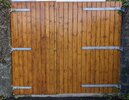Hi all,
I'm looking to fix an outward opening gate to the inside face of a pillar (built from concrete blocks). I'm thinking of using 24"/30" hook and band hinges.
Can these hook plates be fixed into concrete block? I see most people fix them into timber gate posts but I want to avoid that to preserve the full width that's already there.
Does fixing the hook plate into masonry work using a wedge/sleeve anchor or why does everyone seem to fix them into timber?
Thanks
I'm looking to fix an outward opening gate to the inside face of a pillar (built from concrete blocks). I'm thinking of using 24"/30" hook and band hinges.
Can these hook plates be fixed into concrete block? I see most people fix them into timber gate posts but I want to avoid that to preserve the full width that's already there.
Does fixing the hook plate into masonry work using a wedge/sleeve anchor or why does everyone seem to fix them into timber?
Thanks



